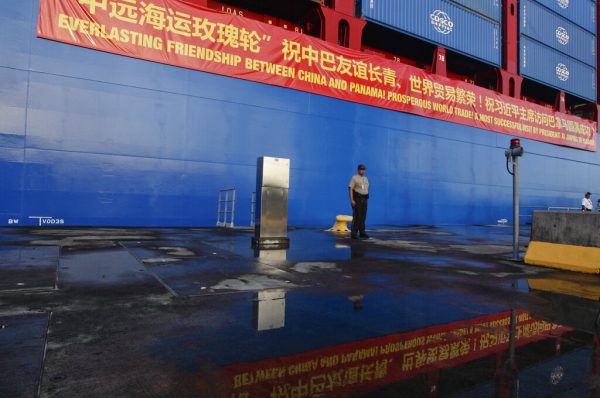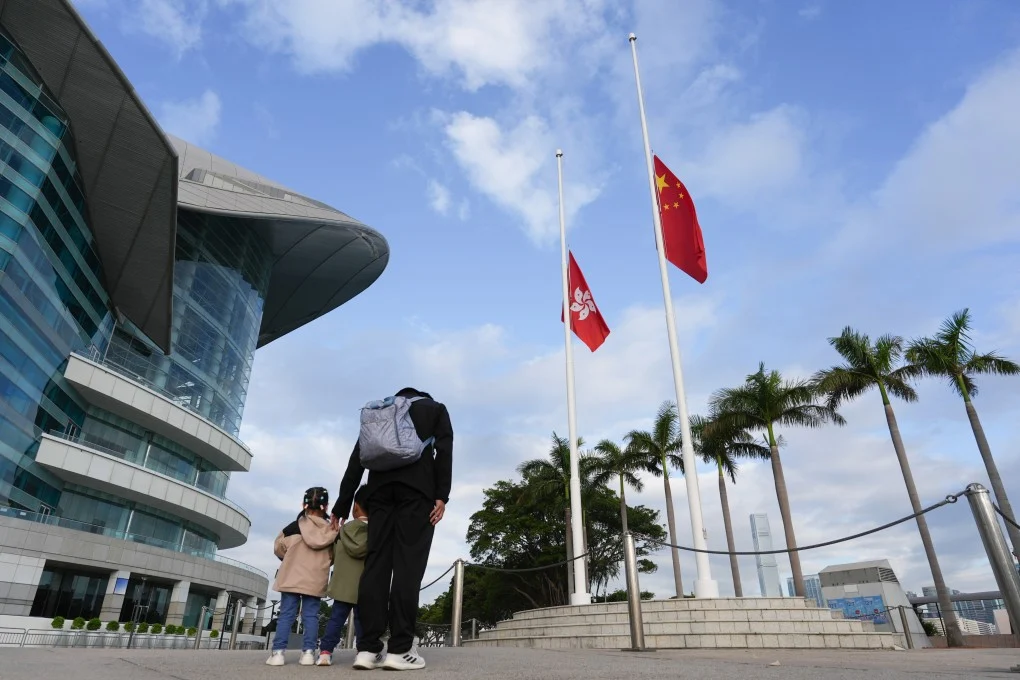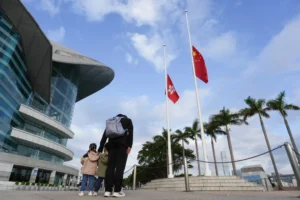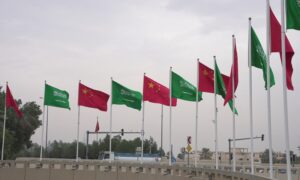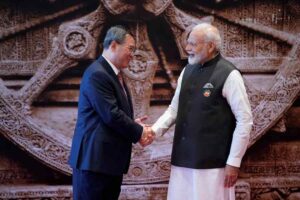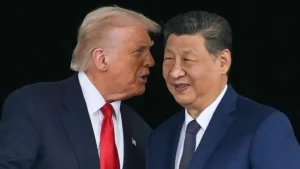China’s New Year Ambitions for Latin America and the Caribbean
In this Dec. 3, 2018, photo, a Panama Canal guard stands at attention in front of a Chinese container ship docked at the Panama Canal’s Cocoli Locks in Panama City, during an official visit by China’s President Xi Jinping and first lady Peng Liyuan.
For anyone wondering where China’s relationship with Latin America and the Caribbean will go in 2022, here is a good place to start: the China-Community of Latin American and Caribbean States (CELAC) Forum Joint Action Plan (2022-2024). As with previous ministerial-level forums in 2015 and 2018, China and CELAC members updated their roadmap for cooperation in various areas. Like China’s 2008 and 2016 Latin America policy white papers, and the 1+3+6 plan announced by President Xi Jinping in 2014 in Fortaleza, Brazil, this plan signals China’s priorities in the region, even if the intentions behind them are less than clear, and its implementation uneven.
An Emphasis on Forums, Multilateralism, and Small Island Developing States
The new plan reinforces China’s intentions to expand its engagement with Latin America and the Caribbean across a broad range of economic sectors, with an emphasis on the construction of infrastructure in multiple domains, using associated China-provided financing vehicles, and deepening China’s presence in an array of strategic technology sectors. Key to advancing this cooperation is a notably large number of current and/or proposed China-CELAC forums (22 in total) to further specific initiatives.
China-LAC Forums for 2022-2024 Ongoing (14) China-LAC Infrastructure Cooperation Forum
China-LAC Business Summit
High-Level China-Latin America Investment and Cooperation Forum
China-CELAC Infrastructure Cooperation Forum
China-Caribbean Economic and Trade Cooperation Forum
China-CELAC Forum of Ministers of Agriculture
China-CELAC Science, Tech, and Innovation Forum
China-CELAC Digital Technology Anti-Epidemic Cooperation Forum
China-CELAC Poverty Reduction and Development Forum
China-LAC Martial Arts Exchange Forum
China-LAC Think Tanks Forum
China-CELAC High-Level Academic Forum
China-CELAC Local Government Cooperation Forum
China-LAC People’s Friendship Forum Proposed (8) China-CELAC Space Cooperation Forum
China-LAC Legal Forum
China-CELAC Digital Technology Cooperation Forum
China-CELAC Transportation Cooperation Forum
China-CELAC Private Sector Cooperation Forum
China-CELAC University Dean Forum
China-LAC Youth Development Forum
China-LAC Media Forum
Diplomat Brief Weekly Newsletter N Get briefed on the story of the week, and developing stories to watch across the Asia-Pacific. Get the Newsletter
The document makes clear that Beijing sees CELAC as a strategic vehicle for multilateral engagement with the hemisphere and explicitly embraces strengthening CELAC as an institution. By implication, such strengthening would come at the expense of the Organization of American States (OAS), the region’s traditional architecture for multilateral engagement, in which the United States and Canada have a seat at the table as part of the Western Hemisphere. China also pledged to “support the parallel advancement and mutual promotion” of the Forum on Latin America and East Asia Cooperation, although what such promotion entails remains unclear.
Enjoying this article? Click here to subscribe for full access. Just $5 a month.
China also stated that it would provide “key support to strategic projects… particularly favoring” Caribbean Small Island Developing States. China views the Caribbean subregion as geostrategically important because of its proximity to the United States. Furthermore, Beijing wants to continue flipping the eight remaining countries that have diplomatic relations with Taiwan in the Western Hemisphere, five of which are Caribbean states (Haiti, Belize, St. Lucia, St. Kitts and Nevis, and St. Vincent and the Grenadines). The region also is a strong voting bloc in the U.N. and OAS that China could influence.
Defense and Law Enforcement
In the defense realm, the new document is notably silent, despite the range of ongoing defense cooperation initiatives that could have been mentioned, perhaps reflecting Chinese perception of U.S. sensitivity toward its defense engagement in the region. Although the document notably does not have a section on security cooperation, it does, however, mention support for the ongoing China-Latin America Superior Defense Forum, a possible tool for China-Latin America coordination on security issues at the strategic level.
The document also mentions the promotion of cooperation in the aeronautical sector, among both private companies and governments. While germane to space cooperation, aeronautical collaboration also potentially encompasses China’s initiative to sell its JF-17/FC-1 fighter to the Argentine Air Force, in addition to prior sales and donations of military aircraft and helicopters to Venezuela (K-8, Y-8, Y-12), Bolivia (Z-9, K-8), Guyana (Y-12), Colombia (Y-12), and Costa Rica (Y-12), as well as a range of air defense systems and radars.
Of particular interest, the document briefly also mentions collaboration in Antarctica. While the Chinese have long had research stations in the area, logistically supported from the south of Chile, the pro-Beijing Argentine government’s recent decision to develop a polar logistics base in Ushuaia, and its possible location of a space communications facility in the area, raises the prospect of an expanded strategic presence by China, including the icebreaker Xue Long II and PLA Navy ships, in the area.
In law enforcement, the document builds on the language of the prior 2019-2022 plan mentioning China’s intention to expand collaboration with Latin American governments in a range of areas including cybersecurity, counternarcotics, money laundering, and the fight against corruption. While the United States also collaborates with Latin American governments in these areas, such engagement would be a substantially new area for China, and potentially provide it with sensitive insights into the workings of Latin American security forces and personnel, U.S. training, and the vulnerabilities of private and public sector elites in the region potentially subject to anti-corruption investigations.
Trade, Investment, and Mining
In many areas, while superficially benevolent, the document highlights China’s continuing maneuvering to secure access to the region’s resources, markets, and technology on conditions to its advantage. For example, a reference to “cooperation in judicial practices” can be understood as Beijing’s attempt to develop an understanding of and influence in Latin American legal institutions impacting the operation of its companies in the region.
The wording of the plan contains substantial emphasis and language borrowed from the policy agenda of the current Chinese government, including Xi’s Global Development Initiative, emphasizing a decidedly “green” focus on investment and technology initiatives.
While the document is relatively open about China’s interest in Latin America’s agricultural exports, its interest in the region’s mineral resources is a bit more oblique. A reference in the energy section to China’s interest in Latin America’s “geological and energy mining resources,” for example, can be understood as a reference to its ongoing work to secure access to lithium in Chile, Argentina, and Bolivia, as well as Mexico (Bacanora).
Enjoying this article? Click here to subscribe for full access. Just $5 a month.
With respect to infrastructure, the document references and attempts to build on vague but positive language in the prior 2019-2022 plan about promoting Xi’s Belt and Road Initiative in the region. It makes clear China’s desire to not only expand its position in transportation logistics projects such as ports, highways, rail, metro systems, and riverine transport, but also in electricity generation and transmission, telecommunications, e-commerce, and space, among other areas. In addition to the ongoing China-CELAC Infrastructure Cooperation Forum, the latest Joint Action Plan mentions a proposed new “Transportation Cooperation Forum,” the only time in the document in which it says that a proposed new forum should be initiated “as soon as possible.”
The document mentions collaboration on “climate change,” which could include loan-supported construction projects to mitigate the effects of sea-level rise, or to rebuild or harden facilities affected by weather events. Working together on “climate change” could also be a reference to Chinese work on a number of areas in renewable energy generation and transmission. China currently is seeking to advance its technologies through loan-backed projects worked by its companies, including wind farms, photovoltaic arrays, electric cars and buses, hydroelectric facilities, or nuclear plants (possibly in Brazil’s Angra complex, in addition to agreed to work by the Chinese at Argentina’s Atucha complex), among others. Indeed, the plan explicitly highlights nuclear energy promotion and associated personnel training in a special section.
Finance
In the domain of financing of the Chinese initiatives, the document incorporates but also moves beyond prior language about support from Chinese policy banks or co-financing funds. It talks about deepening cooperation between Chinese and Latin American financial institutions, and specifically mentions collaborations between the China-engineered Asian Infrastructure Investment Bank (AIIB) and the BRICS New Development Bank and regional financial institutions such as the Latin America Development Bank (CAF) and the Caribbean Development Bank.
As in past Chinese policy initiatives, such financial cooperation is designed not simply to provide funds for work that benefits Chinese companies, but as a secondary benefit, as part of a broader global strategy to advance use of the Chinese renminbi as a global currency and move away from the dominance of the dollar in global commercial and financial transactions. Indeed, the document explicitly mentions the promotion of “settlement in local currencies” (e.g. getting away from dollar-denominated transactions).
5G and Cybersecurity
The document specifically notes China’s interest in expanding its cooperation in a range of strategic technologies, including 5G, “big data,” cloud computing, the Internet of Things, and artificial intelligence. It notably mentions interest in implementing further “Smart Cities” initiatives, an area in which China’s advance through projects such as ECU-911, BOL-911, and others raise serious privacy concerns, as well as give China potential access to data not only on the movement of persons, but also their financial, health, and other sensitive information.
The plan also gives new interest to cyberspace cooperation, including collaboration on the establishment of norms and rules, as well as cybercrime and cybersecurity. Such cooperation implies the potential to set standards that expand the advantage of Chinese providers such as Huawei, as well as giving the Chinese access to information architectures and the region’s government and cybersecurity personnel to monitor them. Such initiatives arguably build on China’s Global Initiative on Data Security, China’s effort to counter the United States’ “Clean Network” initiative designed to limit the presence of untrusted Chinese vendors from global architectures, with the associated cyberespionage concerns.
Space Cooperation
In the space arena, China lays down a marker for its interest in expanding its engagement through a proposed China-CELAC space cooperation forum. The China-CELAC 2022-2024 plan specifically mentions Beijing’s interest in promoting use of its Beidou satellite constellation in the region (potentially a way to rival the U.S.-created Global Positioning System), an invitation for Latin American countries to join China’s proposed lunar research station, and Chinese engagement with a potential new Latin America and Caribbean Space Agency, as well as other forms of cooperation. This is all in addition to China’s already significant work developing and launching satellites for Brazil, Venezuela, and Bolivia, a deep space radar facility in Neuquen, Argentina, and astronomy facilities in Argentina and Chile, among others.
Health and Food Security
In the section on health and medical engagement, China intends to continue selling COVID-19 vaccines to Latin America, including production in select countries of the region, and the possible development of new vaccines through “joint laboratories” as COVID-19 variants continue to emerge. As elsewhere, the language about medical cooperation in the document also suggests a self-serving motive. For instance, it mentions “anti-epidemic loans” for the construction of health infrastructure, presumably hospitals and equipment to be provided by Chinese suppliers using Chinese credit.
Other nods to Latin American socioeconomic needs include promised collaboration on food insecurity and poverty reduction, although both may also be interpreted as opening the door for Chinese companies to provide more loan-financed programs in the region, such as Chinese company COFCO’s acquisition of agro-logistics firms Nidera and Noble for food distribution, or Chinese construction firms that have used Chinese policy bank loans (not donations) to build low income housing for Latin American governments.
Education and Cultural Exchange
The plan emphasizes China’s continuing expansion of people-to-people diplomacy and soft power. It notes continued support to the China-CELAC Academic Forum, an opportunity for China-focused Latin American academics to travel to China on an extended trip, usually covered by the Chinese government, and talk about the potential benefits of increased China-LAC collaboration in this field.
Enjoying this article? Click here to subscribe for full access. Just $5 a month.
Beyond such forums, and parallel to the 2019-2022 plan, Beijing declared that it will provide 5,000 scholarships for Latin Americans to study in China, as well as 3,000 “training places” and a “1,000 talents program” for Latin American youth, the nature of which is not discussed.
The document also discusses support for the continuation and expansion of Confucius Institutes in the region, ironic given the previous attempt to rename the Confucius Institutes, or at least separate their finances from the Chinese cultural funding organization Hanban, due to public controversy over perception of the propaganda function of Confucius Institutes in host countries. It also encourages Latin American and Caribbean countries to incorporate Mandarin into their national curricula, although there is no such reciprocal comment about Chinese students needing to learn Spanish or English. This suggests China’s unequal, one-way attitude toward cultural exchange.
Media Relations and “Hate Speech”
In its section on media affairs, the document contains a potentially concerning, double-edged reference to collaborating against “hate speech,” as well as “terrorism.” China has a track record of using telecommunications and internet technologies as vehicles of the state to suppress discourse opposed by the government on issues such as Tiananmen Square, Hong Kong, and the internment of Uyghurs in Xinjiang. Meanwhile, authoritarian Latin American states such as Venezuela, Nicaragua , and Cuba have used anti-terrorism laws to outlaw opposition groups and arrest political dissidents.
China-Latin America collaboration on “hate speech” or “terrorism” raises the risk of greater Chinese assistance to friendly authoritarian regimes in monitoring communication, as well as identifying and arresting or otherwise suppressing enemies of the state. Huawei technology helped the Cuban telecommunications organization ETESCA to shut down communications between protesters in July 2021, and in Venezuela the Chinese company CEIEC helped the Maduro regime to spy on its opponents.
Although the document is relatively limited in its discussion of international affairs, it does notably express CELAC member support for the Beijing Winter Olympics, an oblique jab at initiatives by the U.S. and other Western governments to diplomatically boycott the Games due to China’s human rights violations of Uyghurs in Xinjiang and other objectionable behaviors.
Conclusion
The health, economic, and fiscal stresses of COVID-19 have made Latin America and the Caribbean particularly vulnerable to China’s advance, including the growing importance of China as a purchaser of the region’s exports, a provider of loans and investment, and a potential purchaser of corporate operations in the region as U.S. and other Western firms seek to sell-off assets to focus in more strongly performing markets. At the same time, the sociopolitical stresses in the region have supercharged the frustrations stemming from endemic corruption, violence, economic stagnation, and inequality in the region, to bring to power an unprecedented number of populists and other left-of-center governments receptive to working with the Chinese. In this context, as China stands poised to expand its commercial presence and associated influence in the region in an unprecedented fashion, the China-CELAC 2022-2024 plan provides a general indication of the directions in which the Chinese government and companies are interested in proceeding.
Regional leaders must ensure that engagement with Beijing and other extra-hemispheric players occurs in a rules-based framework of transparency and equality, under the supervision of strong institutions with technically qualified personnel, and with the full enforcement of relevant national laws on all actors. This will help bolster the region’s sovereignty, as well as maximize the benefits and control the risk of dealing with China – in 2022 and for years to come.
The views expressed in the article are those of the authors and do not necessarily reflect those of the U.S. government.
